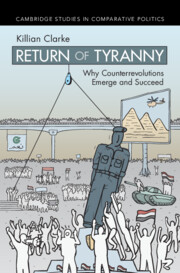Refine search
Actions for selected content:
3387661 results
Chapter 6 - Politics of the Land
- from Part II - The Politics of the Irish Revival
-
-
- Book:
- The Revival in Irish Literature and Culture
- Published online:
- 04 September 2025
- Print publication:
- 18 September 2025, pp 127-144
-
- Chapter
- Export citation
The opposition of omnibenevolence towards evil
-
- Journal:
- Religious Studies , First View
- Published online by Cambridge University Press:
- 18 September 2025, pp. 1-23
-
- Article
-
- You have access
- Open access
- HTML
- Export citation
Contributors
-
- Book:
- Ockham’s <i>Summa Logicae</i>
- Published online:
- 04 September 2025
- Print publication:
- 18 September 2025, pp ix-x
-
- Chapter
- Export citation
Behavioral Genetics and Human Agency: How Selectively Deterministic Theories of Free Will Drive Unwarranted Opposition to Behavioral Genetic Research and Undermine Our Moral and Legal Conventions, Part II
-
- Journal:
- Twin Research and Human Genetics , First View
- Published online by Cambridge University Press:
- 18 September 2025, pp. 1-15
-
- Article
-
- You have access
- Open access
- HTML
- Export citation
Chapter 6 - Visual Space
-
- Book:
- The Neural Structure of Consciousness
- Published online:
- 27 July 2025
- Print publication:
- 18 September 2025, pp 172-201
-
- Chapter
- Export citation
Part I - Artists of African Descent and Cuban Art through the 1930s
-
- Book:
- My Own Past
- Published online:
- 30 September 2025
- Print publication:
- 18 September 2025, pp 1-86
-
- Chapter
- Export citation
Contents
-
- Book:
- Local Greens
- Print publication:
- 18 September 2025, pp vii-viii
-
- Chapter
- Export citation
Copyright page
-
- Book:
- My Own Past
- Published online:
- 30 September 2025
- Print publication:
- 18 September 2025, pp iv-iv
-
- Chapter
- Export citation
Case 14: - Hoarding Disorder
- from Part 1: - Vignettes
-
- Book:
- Practise Psychiatry
- Published online:
- 04 September 2025
- Print publication:
- 18 September 2025, pp 132-137
-
- Chapter
- Export citation
14 - Appraising Global Environmental Governance
- from Part II - Responding to Global Environmental Problems
-
- Book:
- Global Environmental Politics
- Published online:
- 04 September 2025
- Print publication:
- 18 September 2025, pp 312-323
-
- Chapter
- Export citation
Index
-
- Book:
- The Will in English Renaissance Drama
- Published online:
- 04 September 2025
- Print publication:
- 18 September 2025, pp 192-196
-
- Chapter
- Export citation
Part III - Research Paths: Cuba and Afro-Latin America
-
- Book:
- My Own Past
- Published online:
- 30 September 2025
- Print publication:
- 18 September 2025, pp 187-248
-
- Chapter
- Export citation
Chapter 4 - Last Wills and Remembrance
-
- Book:
- The Will in English Renaissance Drama
- Published online:
- 04 September 2025
- Print publication:
- 18 September 2025, pp 130-165
-
- Chapter
- Export citation
Case 44: - Voyeuristic, Exhibitionistic, Frotteuristic and Sexual Masochism and Sadism Disorders
- from Part II: - Topical MCQs
-
- Book:
- Practise Psychiatry
- Published online:
- 04 September 2025
- Print publication:
- 18 September 2025, pp 519-519
-
- Chapter
- Export citation
Chapter 8 - Peripatetic metriopatheia in the Tusculan Disputations
-
-
- Book:
- Cicero's <i>Tusculan Disputations</i>
- Published online:
- 11 September 2025
- Print publication:
- 18 September 2025, pp 142-162
-
- Chapter
- Export citation
Case 23: - Attention Deficit Hyperactivity Disorder
- from Part II: - Topical MCQs
-
- Book:
- Practise Psychiatry
- Published online:
- 04 September 2025
- Print publication:
- 18 September 2025, pp 494-495
-
- Chapter
- Export citation
Introduction
-
-
- Book:
- Rethinking the Lawyers' Monopoly
- Published online:
- 04 September 2025
- Print publication:
- 18 September 2025, pp 1-22
-
- Chapter
-
- You have access
- Open access
- HTML
- Export citation
Chapter Two - Resolving Conceptual Conflation
-
- Book:
- The Archaeology of Pastoralism, Mobility, and Society
- Published online:
- 04 September 2025
- Print publication:
- 18 September 2025, pp 56-104
-
- Chapter
- Export citation

Return of Tyranny
- Why Counterrevolutions Emerge and Succeed
-
- Published online:
- 17 September 2025
- Print publication:
- 23 October 2025

National Human Rights Institutions in Europe and Latin America
- International and Comparative Perspectives
-
- Published by:
- Intersentia
- Published online:
- 17 September 2025
- Print publication:
- 19 February 2024
